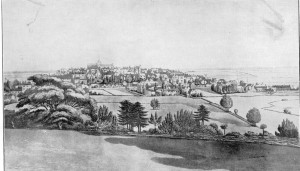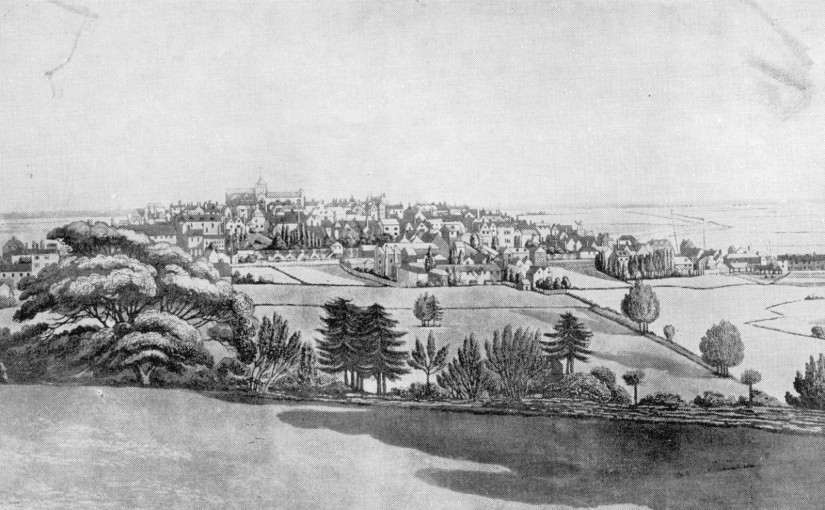by Rya
Part 16 William Holloway, Historian of Rye
William Holloway was born on 1st August, 1785 at Emsworth in Hampshire of a merchant family. At the age of seven he was sent to Midhurst Grammar School, where he received a good classical education as well as a certain amount of disciplinary “flogging.” A successful schoolboy, he finished his school days by winning a Latin verse competition, receiving as a prize nothing less than Milton’s “Poems” in two finely bound octavo volumes. Holloway then applied himself—perhaps, not very seriously—to studying agriculture. In 1802 he was sent as a pupil to a large farm at Kingston-by-sea belonging to a Mr. William Gorringe, where, although he was not taught much practical farming, he kept his own horse and became an excellent rider journeying on one occasion as far as London in one day. In 1804 he returned to Emsworth to spend one of the happiest years of his life, enjoying such simple pleasures as “A little Hunting: a little social Visiting: with now and then a Ball: a great deal of reading through the Winter, followed by travelling in the Summer.” His account of the final pleasure—travelling—showed that “in early life Holloway possessed the enquiring mind,” writes G. S. Bagley, “that later led to his researches into the history of Rye and its neighbourhood.” In the next year he came into possession of a farm at Leigh, with but little knowledge of agriculture. Instead of devoting all his energies to making a success of farming, he continued to pursue his simple pleasures of visiting theatres, races, libraries and riding. In 1809 he increased his responsibilities by marrying “one of the most charming young ladies in Rye,” Miss Sarah Meryon, a member of an old Hugenot family, returning with her to Leigh. The death of Mrs. Meryon Snr. in 1820 resulted in Holloway coming to live in Rye with his wife and to his cutting his losses at Leigh. Thus commenced his long and active association with the town.
Soon after his father-in-law’s death in 1824 he not only entered the brewery business with his brother-in-law, John Meryon but took an active part in the public life of his adopted town, being, at various times, an overseer of the Poor, Chairman of the Harbour Commissioners, a Justice of the Peace and President of the Savings Bank. In politics he was a traditional Whig in outlook and, consequently, he joined forces with the “reformers” or malcontents in their attempt to wrest political power from the Lamb family. The story of this period, when Rye had two Mayors for six weeks, has already been described in Part Nine. On one occasion, the “reformers” even removed a large number of the books and papers belonging to the Corporation from the Town Hall for political purposes. The study of such documents would have been Holloway’s job and “it is reasonable to suppose that such reading would incline his interest,” writes G. S. Bagley, “towards the historical writing of his later years.” But, as he gained in prominence in public life, so he lost ground as a man of business. His already proven lack of business ability, the fierce competition of the brewery established by the Lambs, his own conscience and adverse economic conditions—all these factors combined to force him to retire permanently from business in 1842 and to live thereafter, without wines and spirits, on the declining income of his wife’s patrimony. Holloway’s misfortune was Rye’s good luck for he now directed his attention to writing about Rye and the Romney Marsh.
The year 1847 winessed the publication of his greatest work “The History and Antiquities of the Ancient Town and Port of Rye,” the first adequate history of the town. He was, as G. S. Bagley has written, “a late developer as an historian,” being 62 years old at the date of publication. This ‘magnum opus’ consisting of 614 pages must have involved him in a considerable amount of research, even though he did have the benefit of Dr. Meryon’s MS history, which Vidler says he freely used. The work of Samuel Jeake I was not forgotten: in fact, as K. M. Clark says, “revised and re-orientated, much of it was incorporated in Holloway’s ‘History.”’ Within the short space of two years there appeared “The History of the Romney Marsh from its earliest formation to 1837” consisting of 182 pages. His new subject was a difficult one: certain flaws inevitably appeared, particularly in his examination of the evidence on the site of Anderida. If this had been the total sum of his literary output, he would have been assured of a place among the great men of Rye. In the event, however, he was to produce a great deal more, including learned articles, a diary, a catalogue of the town’s archives, an autobipgraphy and much poetry.
Of the many poems he composed the most famous appeared in 1859 (printed by D Taylor of Rye) entitled “Rye: A Ballad,” of which the following is an amusing extract.
“At length the Pirate’s trade died out,
But he [the Ryer] was persevering;
Compell’d to give up Pirating,
He took to Privateering.
The Privateering died also;
But still with fate he struggled,
So when the Privateering died,
Why then — our Pirate smuggled.
And now the Coast-guard officers
And men so guard the shore,
That Privateering, Pirating,
And Smuggling are no more.”
In 1863, the first volume of his “Antiquarian Rambles through Rye” was published, which— together with the second volume thereof of 1866—were intended as an appendage to his “History.” Written in his most attractive prose, they contain a great deal of contemporary descriptions of Rye, its streets, houses and people. It is doubtful if the description of his own house could be bettered today:
No. 24 High Street. .. and of which the adjoining house of Mr. Banks on the west side of it originally formed part, some portion of the latter overlapping the former, and these two together present a united frontage towards the south of 64 feet and a depth from south to north of 44 feet. In our own dwelling are many features of antiquity; in the first place we have (though now concealed by more modern ones) three chimney pieces of Caen Stone, having sculptured on them, the Tudor Rose and also the Portcullis, which was borne in the arms of this family. In this house is a vast mass of timber, most rudely finished, seemingly only rough hewed by an axe, and over which no plane has ever passed, and which is now too hard for a chisel to cut. Our house and the old Mermaid are the only two we have met with, as having an open quadrangle in the centre, the which, in our case, was covered over some 50 or 60 years ago, while in the latter it is still open to the sky. We will here give a specimen of one room in our house, serving to show what style prevailed in the 16th century—This apartment is wainscotted, but, in the course of three centuries, as might be reasonably expected, has been sadly disfigured; but still enough remains to show that in many parts it was handsomely carved. From the open quadrangle, we suppose, from the inferior appearance of the wainscot in that part, at the present time; the room was entered by two folding doors of great loftiness, reaching within two feet of the top which is 10 feet high; immediately facing this entrance was one very large window with small panes, looking towards the north, while pretty near the upper corner of this, on either side, was a very small one, still in existence, though concealed by plaster on the outside, and by a square of wainscot within. On the right as you entered was one of those Massy chimney pieces which we have already mentioned; on the west side is a solid plate running the whole length of 16 feet which is the square of the room, projecting a few inches from the perpendicular of the wainscot, which is so hard no tool can cut it.”
In 1868 he lost his wife only to die himself just two years later. His body was laid to rest above the bodies of his wife and son in the St. Nicholas chapel of the parish church.

What is the verdict of posterity on the man whom H. P. Clark described as “the only star of any magnitude shining in its [Rye’s] hemisphere, whom Rye is proud of ?“ Will he, as he feared himself, ever be forgotten? These are difficult questions to answer. Certainly, the local printers such at Taylor, Cole, Joseph Adams and Deacon relied entirely on the “History” and the “Antiquarian Rambles” for the facts they presented in their guides. It was not until L. A. Vidler arrived on the scene that many of Holloway’s surmises and conclusions were challenged and rejected. Even then, as K. M. Clark has proved, “Vidler came not to destroy the work of Jeake and Holloway, but to correct and amplify it.” Despite the enormous amount of research Vidler himself conducted, he was unable for a variety of reasons to produce a definitive history of the town. That job has still to be done and the historian who undertakes it will undoubtedly find Holloway’s writings indispensable, especially his most readable “Antiquarian Rambles,” which, as a detailed description of Rye in the 1860’s, will ensure that his name will never be forgotten.
